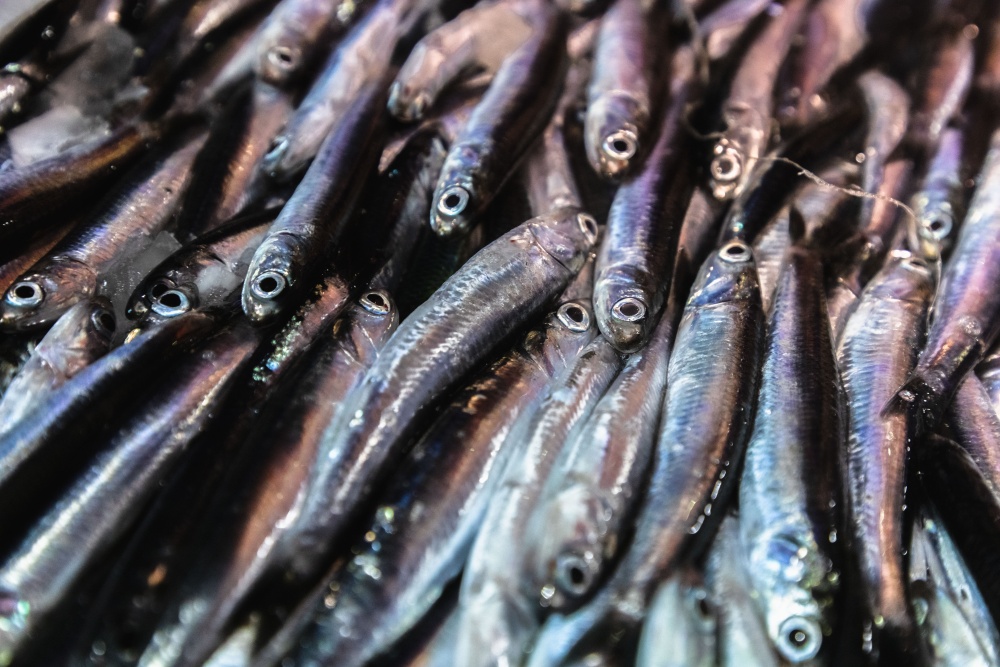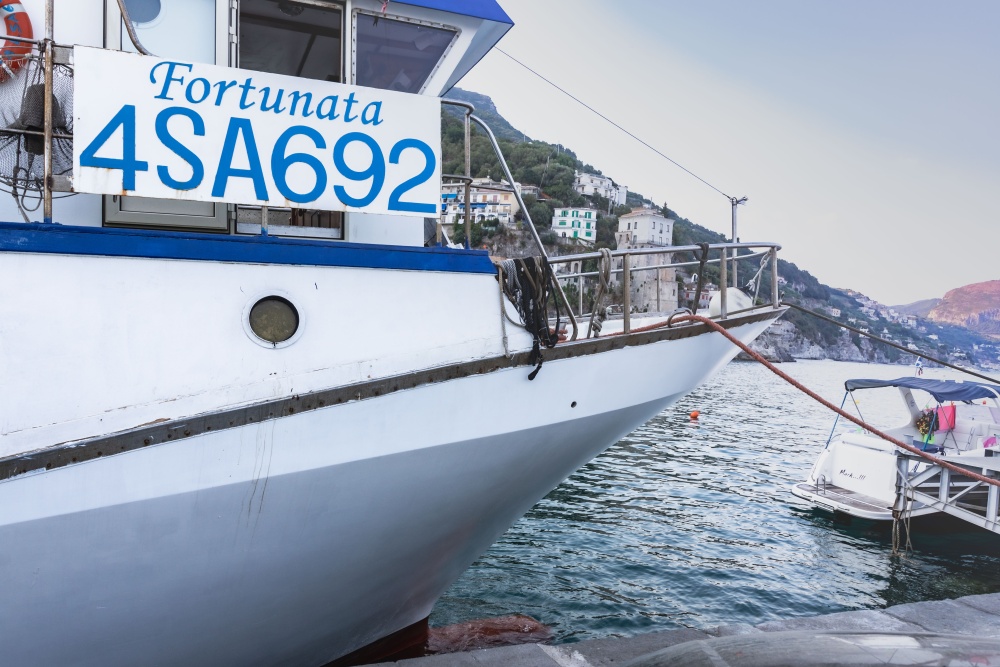























































PESCA DELLE ALICI
un'esperienza da vivere
L'appuntamento è alle ore ore 19:00 al porto di Cetara. Trovare una motonave bianca "Fortunata" alla fine del molo. Arrivo un quarto d'ora prima del previsto. Non c'è nessuno ancora. Poi alla spicciolata arrivano i componenti dell'equipaggio con le loro borse in cui probabilmente vi è la colazione per la traversata. Finalmente arriva il mio amico, Secondo Squizzato (presidente associazione "Amici delle Alici"), che mi ha permesso di partecipare alla battuta di pesca delle alici. Saliamo a bordo. Un saluto cordiale a tutti i presenti. Piano piano inizia la sistemazione. Poi arrivano il comandante Domenico Sperandeo insieme al figlio Bernardo. Una stretta di mano e un ringraziamento per avermi accolto a bordo.
La tecnica di pesca usata è quella detta del 'cianciolo', con l'uso delle lampare, effettuata dalla imbarcazione madre con l'appoggio di due piccole barchette, dotate di grosse luci, dette appunto "lampare", installate ed alimentate da un generatore alimentato a gasolio. Una volta raggiunta la zona di pesca, anche con il supporto dell’eco-scandaglio capace di valutare la possibile massa delle alici in profondità, le due piccole barchette sono state calate in acqua e i due marinai hanno azionato le lampare per attirare dal fondale le alici sedotte dal grande bagliore della luce artificiale della lampara.
Quando i banchi di pesce azzurro si sono radunati sotto le chiglie, le barchette si sono avvicinate. La barca madre ha gettato in mare la rete tesa in verticale che portava sul lato alto dei sugheri galleggianti, mentre nella parte inferiore portava dei piccoli piombi che la stendono formando una parete mobile, in modo da disegnare sul mare una circonferenza che lentamente circonda il pesce ammassato in un piccolo spazio. Quando il cerchio si è chiuso, le lampare sono uscite dalla rete e il pesce è rimasto intrappolato. Da bordo sono state tirate le cime per chiudere la rete sul fondo, come un sacco, pieno di pescato. Piano piano viene issata a bordo.
La luce delle lampare, il getto e il recupero delle reti sono stati momenti incredibili, frenetici e fantastici. Tutti concentrati durante le operazioni. Nessuno scherzava in quei momenti perché per loro questo è lavoro faticoso, fonte di sostentamento per le proprie famiglie. Alla fine un buon bottino di alici bellissime. La notte è trascorsa veloce fra chiacchiere con i membri dell’equipaggio, qualche chiusura d'occhio, momenti solitari e momenti magici sotto le stelle, in mezzo al mare.
Devo dire che non è un’esperienza per tutti, fisicamente è un po’ pesante. Serve un po’ di spirito di adattamento e voglia di avventura. Nove ore di notte su un vero peschereccio al largo della Costiera Amalfitana, fra Cetara e Positano.
ANCHOVY FISHING
an experience to live
7 PM rendezvous — port of Cetara. Ran into a motor fishing vessel christened Fortunata, docked at the tip of the pier. No one — for I had gotten there a quarter of an hour earlier than expected. Then the crew members started to trickle in — their bags — probably their breakfasts in them, sea-crossing victuals. Finally, my friend came: Secondo Squizzato, president of the Amici delle Alici association. It was he who let me partake in the anchovy fishing trip. We get aboard — I bade greetings to everyone present. Slowly, all’s set. And then the captain, Domenico Sperandeo, arrives with his son Bernardo. A manly handshake — grazie for letting me on board.
The fishing technique, known as del cianciolo, employs a mother-boat supported by two smaller ones — all equipped with a lampara big fishing light attractor powered by a diesel-fueled generator. Once the boat reaches the fishing area, with the additional support of an echo sounder able to evaluate the possible mass of the anchovies down below, the two small ones get lowered into the water and two mariners activate the lampare — an artificial light whose great glow lures the anchovies from the depths.
When schools of fish had gathered under the keels, the boatlets closed in on the mother, as she cast the vertically-stretched net sporting cork buoys on the upper and small plumb bobs on the lower side — thus tracing on the water and down below forming a mobile sounding wall, an enclosure slowly encircling and amassing the fishes in one tight spot. When the mother comes full circle and the loop is closed, the lampare boatlets egress and the anchovies are trapped. The men on board pulled the ropes, and the net closed at the bottom like a sack — the fishful catch being slowly hoisted onboard.
The nightly lambent gleam of the lampare fluttering, glistering on the blueish ghostly-glaring lullingly calm waters — the splashing casting and creaking hoisting of nets — incredible, hectic, awe-inspiring moments… Everyone focusing on the operations — no usually-indulged sailorly joke would crack the hard work’s taciturnity, perturb the hallowed source of families’ livelihoods. Finally, a bountiful haul of pulchritudinous anchovies. The antelucan remainder of the night whiled away quickly, scatteredly populated by chats with the crew members, weighty eye contacts, pensive instants and charmed moments under the bestarred welkin, in the middle of the tenebrous sea.
I have to say — not an experience for everyone, physically demanding as it is. Spirit of adaptation and a penchant for adventure are required. Nine nocturnal hours floating — a real fishing boat off the Amalfi Coast — Cetara and Positano.
Translation by Alfonso Mauro.
L'appuntamento è alle ore ore 19:00 al porto di Cetara. Trovare una motonave bianca "Fortunata" alla fine del molo. Arrivo un quarto d'ora prima del previsto. Non c'è nessuno ancora. Poi alla spicciolata arrivano i componenti dell'equipaggio con le loro borse in cui probabilmente vi è la colazione per la traversata. Finalmente arriva il mio amico, Secondo Squizzato (presidente associazione "Amici delle Alici"), che mi ha permesso di partecipare alla battuta di pesca delle alici. Saliamo a bordo. Un saluto cordiale a tutti i presenti. Piano piano inizia la sistemazione. Poi arrivano il comandante Domenico Sperandeo insieme al figlio Bernardo. Una stretta di mano e un ringraziamento per avermi accolto a bordo.
La tecnica di pesca usata è quella detta del 'cianciolo', con l'uso delle lampare, effettuata dalla imbarcazione madre con l'appoggio di due piccole barchette, dotate di grosse luci, dette appunto "lampare", installate ed alimentate da un generatore alimentato a gasolio. Una volta raggiunta la zona di pesca, anche con il supporto dell’eco-scandaglio capace di valutare la possibile massa delle alici in profondità, le due piccole barchette sono state calate in acqua e i due marinai hanno azionato le lampare per attirare dal fondale le alici sedotte dal grande bagliore della luce artificiale della lampara.
Quando i banchi di pesce azzurro si sono radunati sotto le chiglie, le barchette si sono avvicinate. La barca madre ha gettato in mare la rete tesa in verticale che portava sul lato alto dei sugheri galleggianti, mentre nella parte inferiore portava dei piccoli piombi che la stendono formando una parete mobile, in modo da disegnare sul mare una circonferenza che lentamente circonda il pesce ammassato in un piccolo spazio. Quando il cerchio si è chiuso, le lampare sono uscite dalla rete e il pesce è rimasto intrappolato. Da bordo sono state tirate le cime per chiudere la rete sul fondo, come un sacco, pieno di pescato. Piano piano viene issata a bordo.
La luce delle lampare, il getto e il recupero delle reti sono stati momenti incredibili, frenetici e fantastici. Tutti concentrati durante le operazioni. Nessuno scherzava in quei momenti perché per loro questo è lavoro faticoso, fonte di sostentamento per le proprie famiglie. Alla fine un buon bottino di alici bellissime. La notte è trascorsa veloce fra chiacchiere con i membri dell’equipaggio, qualche chiusura d'occhio, momenti solitari e momenti magici sotto le stelle, in mezzo al mare.
Devo dire che non è un’esperienza per tutti, fisicamente è un po’ pesante. Serve un po’ di spirito di adattamento e voglia di avventura. Nove ore di notte su un vero peschereccio al largo della Costiera Amalfitana, fra Cetara e Positano.
ANCHOVY FISHING
an experience to live
7 PM rendezvous — port of Cetara. Ran into a motor fishing vessel christened Fortunata, docked at the tip of the pier. No one — for I had gotten there a quarter of an hour earlier than expected. Then the crew members started to trickle in — their bags — probably their breakfasts in them, sea-crossing victuals. Finally, my friend came: Secondo Squizzato, president of the Amici delle Alici association. It was he who let me partake in the anchovy fishing trip. We get aboard — I bade greetings to everyone present. Slowly, all’s set. And then the captain, Domenico Sperandeo, arrives with his son Bernardo. A manly handshake — grazie for letting me on board.
The fishing technique, known as del cianciolo, employs a mother-boat supported by two smaller ones — all equipped with a lampara big fishing light attractor powered by a diesel-fueled generator. Once the boat reaches the fishing area, with the additional support of an echo sounder able to evaluate the possible mass of the anchovies down below, the two small ones get lowered into the water and two mariners activate the lampare — an artificial light whose great glow lures the anchovies from the depths.
When schools of fish had gathered under the keels, the boatlets closed in on the mother, as she cast the vertically-stretched net sporting cork buoys on the upper and small plumb bobs on the lower side — thus tracing on the water and down below forming a mobile sounding wall, an enclosure slowly encircling and amassing the fishes in one tight spot. When the mother comes full circle and the loop is closed, the lampare boatlets egress and the anchovies are trapped. The men on board pulled the ropes, and the net closed at the bottom like a sack — the fishful catch being slowly hoisted onboard.
The nightly lambent gleam of the lampare fluttering, glistering on the blueish ghostly-glaring lullingly calm waters — the splashing casting and creaking hoisting of nets — incredible, hectic, awe-inspiring moments… Everyone focusing on the operations — no usually-indulged sailorly joke would crack the hard work’s taciturnity, perturb the hallowed source of families’ livelihoods. Finally, a bountiful haul of pulchritudinous anchovies. The antelucan remainder of the night whiled away quickly, scatteredly populated by chats with the crew members, weighty eye contacts, pensive instants and charmed moments under the bestarred welkin, in the middle of the tenebrous sea.
I have to say — not an experience for everyone, physically demanding as it is. Spirit of adaptation and a penchant for adventure are required. Nine nocturnal hours floating — a real fishing boat off the Amalfi Coast — Cetara and Positano.
Translation by Alfonso Mauro.



